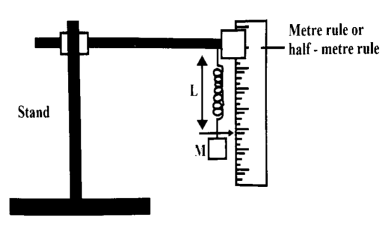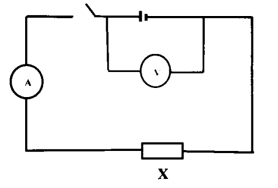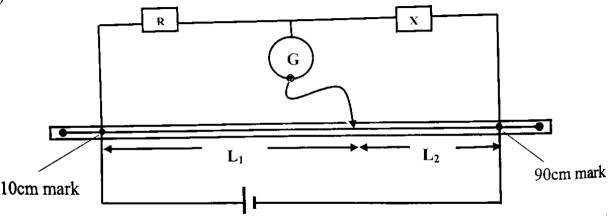INSTRUCTIONS TO CANDIDATES:
- Answer all the questions in spaces provided in the question paper.
- You are supposed to spend the first 15 minutes of 2½ hours allowed for this paper reading the whole paper carefully before commencing the work.
- Marks are given for clear record of the observations actually made, their suitability, accuracy and the use made of them.
- Candidates are advised to record their observations as soon as they are made.
- Mathematical table and electronic calculators may be used.
Question 1
You are provided with the following
- Helical spring with a pointer
- One clamp, one stand and a boss
- A stop watch
- A metre rule or half metre rule
- One 50g, four 20g and one 300g masses
Proceed as follows;
- Suspend the spring vertically alongside the clamped metre rules shown in the figure below. Measure the length L0, of the spring before loading it.
L0 =…………………………………………cm (1 mark) - Attach a mass of 20g on the spring and measure the new length L , of the spring. Record in the table below
- Calculate the change in the length , e=L – L0 due to the mass of 20g and record this in the table below.
- Repeat steps (ii) and (iii) using additional masses of 20g and record your results in the table below.
mass m(g) 20 40 60 80 100 120 L (cm) e=L − Lo, e(cm) - Plot a graph of extension, e (cm) against the mass m (g) (5 marks)
- Determine the gradient S of the graph (2 marks)
- Using the same set up as in the figure above, attach the 120g mass on the spring and support it from below with your palm so that it does not oscillate.
- Pull the mass a small distance vertically downwards and release it to execute Vertical oscillations. Record in the table below the time, t, for 20 complete oscillations. Repeat to obtain a total of three readings i.e., t1, t2 and t3. Repeat the procedure using a mass of 150g. (4 marks)
Time for 20 oscillations Average time (s) Mas (g) t1(s) t2(s) t3(s) t1 + t2 + t3
3T(s) T2(s2) T2/m (S2g−1) 120 150 - Find the average value of Q , given that Q = T2 let this be the (2 marks)
m - Given that the gradient S in (v) given by S = QK , determine the constant K. (2 marks)
4π2
Question 2
You are provided with the following.
- A carbon resistor X
- Resistance wire marked R
- Micrometer screw gauge (to be shared)
- Voltmeter
- Ammeter
- Resistance wire mounted on a mm scale labelled L
- A cell and a cell-holder
- Centre – zero galvanometer
- 8 connecting wires
- Jockey
Proceed as follows.
- Using the micrometer screw gauge, measure and record the diameter D of the resistance wire R provided.
D =…………………………………..m (2 marks) - Set up the following circuit
- Record the voltmeter reading when the switch is open
E=……………………………………………….V (1 mark) - Close the switch and record the voltmeter and ammeter readings V and I.
V=……………………………………………… V (1 mark)
I= ……………………………………………….A (1 mark) - Account for the difference of E and V (2 mark)
- Now connect the voltmeter across the carbon resistor X and record voltmeter reading V1
V1=………………………………………………. V (1 mark) - Calculate X given that X = V1 (2 mark)
1
- Record the voltmeter reading when the switch is open
- Connect another circuit as shown below
- Move the sliding pointer along the resistance wire until the galvanometer reading comes to zero. Record L1 and L2.
- Obtain the value of the unknown resistance R given that; R/x = L1/L2 let it be R1
- Interchange the positions of R and X and repeat the procedure in (i) above and calculate the value of R.
X/R = L1/L2 let it be R2 - Complete the table below with the values of L1, L2, R1 and R2. (6 marks)
Trial 1 L1 (cm) R1 = L2(cm) Trial 2(after interchanging) L1(cm) R2 = L2(cm) - Calculate the average value of R (2 marks)
- Given that, R = 35S determine the value of S (2 marks)
100πD2
CONFIDENTIAL
Question 1
- Spiral spring 3′′ with a pointer
- One clamp, one stand and a boss
- A stop watch
- A metre rule or half metre rule
- One 50g, four 20g and one 100g masses
Question 2
- A carbon resistor 10 ohms Labelled as X
- Resistance wire 50 cm long SWG-32 marked R (Coiled or mounted)
- Micrometer screw gauge (to be shared)
- Voltmeter
- Ammeter
- Resistance wire mounted on a mm scale labelled L
- A 1.5V cell and a cell-holder
- Centre – zero galvanometer
- 8 connecting wires
- Jockey
MARKING SCHEME
Question 1
You are provided with the following
- Helical spring with a pointer
- One clamp, one stand and a boss
- A stop watch
- A metre rule or half metre rule
- One 50g, four 20g and one 300g masses
Proceed as follows;
- Suspend the spring vertically alongside the clamped metre rules shown in the figure below. Measure the length L0, of the spring before loading it.
L0 =…………1d.p a must………………………………cm (1 mark) - Attach a mass of 20g on the spring and measure the new length L , of the spring. Record in the table below
- Calculate the change in the length , e=L – L0 due to the mass of 20g and record this in the table below.
- Repeat steps (ii) and (iii) using additional masses of 20g and record your results in the table below.
1 d.p mustmass m(g) 20 40 60 80 100 120 L (cm) ✓½ ✓½ ✓½ ✓½ ✓½ ✓½ e=L − Lo, e(cm)
Correct sub 1 mark - Plot a graph of extension, e (cm) against the mass m (g) (5 marks)
S = 1
P = 2
L = 1
A1 = 1
5 - Determine the gradient S of the graph (2 marks)
Correctly substracted values ✓1
correct gradient with correct units ✓1 - Using the same set up as in the figure above, attach the 120g mass on the spring and support it from below with your palm so that it does not oscillate.
- Pull the mass a small distance vertically downwards and release it to execute Vertical oscillations. Record in the table below the time, t, for 20 complete oscillations. Repeat to obtain a total of three readings i.e., t1, t2 and t3. Repeat the procedure using a mass of 150g. (4 marks)
Time for 20 oscillations Average time (s) Mas (g) t1(s) t2(s) t3(s) t1 + t2 + t3
3T(s) T2(s2) T2/m (S2g−1) 120 ✓½ ✓½ 150 ✓½ ✓½ - At least 2 correct for each column
- 2 d.p a must
- @ two correct
- 4 s.f a must
- Find the average value of Q , given that Q = T2 let this be the (2 marks)
m
Correct substitution ✓1
Correct ans with corrrect units ✓1 - Given that the gradient S in (v) given by S = QK , determine the constant K. (2 marks)
4π2
Correct substitution ✓1
Correct answer ✓1
Question 2
You are provided with the following.
- A carbon resistor X
- Resistance wire marked R
- Micrometer screw gauge (to be shared)
- Voltmeter
- Ammeter
- Resistance wire mounted on a mm scale labelled L
- A cell and a cell-holder
- Centre – zero galvanometer
- 8 connecting wires
- Jockey
Proceed as follows.
- Using the micrometer screw gauge, measure and record the diameter D of the resistance wire R provided.
D =……………5 d.p a must……………………..m (2 marks)
Correct measurement ✓1
Correct conversion ✓1 - Set up the following circuit
- Record the voltmeter reading when the switch is open
E=………1 d.p a must…… ✓1………………………………….V (1 mark) - Close the switch and record the voltmeter and ammeter readings V and I.
V=…………1 d.p a must… ✓1………………………………… V (1 mark)
I= ………2 d.p a must… ✓1…………………………………….A (1 mark) - Account for the difference of E and V (2 mark)
- Due to lost voltage ✓1 caused by internal resistance of the cell ✓1
- Now connect the voltmeter across the carbon resistor X and record voltmeter reading V1
V1=……………1 d.p a must…………………………………. V (1 mark) - Calculate X given that X = V1 (2 mark)
1
Correct substitution ✓1`
Correct ans with correct unit ✓1
- Record the voltmeter reading when the switch is open
- Connect another circuit as shown below
- Move the sliding pointer along the resistance wire until the galvanometer reading comes to zero. Record L1 and L2.
- Obtain the value of the unknown resistance R given that; R/x = L1/L2 let it be R1
- Interchange the positions of R and X and repeat the procedure in (i) above and calculate the value of R.
X/R = L1/L2 let it be R2 - Complete the table below with the values of L1, L2, R1 and R2. (6 marks)
4 s.f a mustTrial 1 L1 (cm) ✓1 R1 = ✓1 L2(cm) ✓1 Trial 2(after interchanging) L1(cm) ✓1 R2 = ✓1 L2(cm) ✓1 - Calculate the average value of R (2 marks)
correct sub ✓1
Correct ans ✓1 - Given that, R = 35S determine the value of S (2 marks)
100πD2
correct sub ✓1
Correct ans ✓1
Download Physics Paper 3 Questions and Answers with Confidential- Sukellemo Joint Pre Mock Exams 2023.
Tap Here to Download for 50/-
Get on WhatsApp for 50/-
Why download?
- ✔ To read offline at any time.
- ✔ To Print at your convenience
- ✔ Share Easily with Friends / Students



